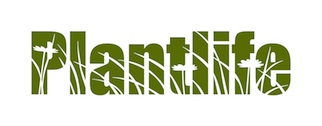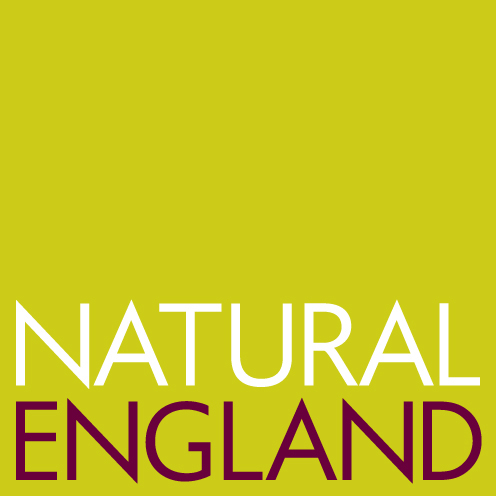Parkers Piece & Bleyswycks Bank

Parkers Piece with Thelnetham Mill in the background
Background
Parkers Piece and Bleyswycks Bank and were purchased by the LOHP in autumn 2007 and named after their former owners. The sites, in the parish of Thelnetham, are adjacent to one another and contribute a further 5.3ha to the land managed for wildlife in the Little Ouse Headwaters. They have over 500m of river-front, including the only section that, although overdeepened, has not been canalised and still has meanders. These sites are particularly strategic for the valley's wildlife because they lie between Thelnetham and Blo'Norton Fens, two of the fragmented sites included within the Waveney and Little Ouse Valley Fens Special Area of Conservation (SAC). Part of Parkers Piece was included within the boundary of the Blo'Norton and Thelnetham Fens SSSI to ensure that it could not be managed in a way that would threaten the hydrology of Thelnetham Fen.
On the 1885 Ordnance Survey map, part of Parkers Piece is labelled as 'Thelnetham Fen': it is clear that this area supported fen vegetation that was continuous with that on Thelnetham Middle Fen, one of the village 'poors' fens. Deep peat, characteristic of the other fens in the valley, underlies much of the area. However, aerial photograph evidence shows that both sites have been used for arable agriculture at some point in the last 60 years. In the 1980s free-range pigs were kept on Parker's Piece, resulting in enrichment of the peat. This, together with drying-out of the valley as a result of artesian abstraction, compounded by droughts, resulted in the development of tall, coarse vegetation, dominated by stinging nettles and creeping thistles. Wetter conditions in the valley since 2000, have resulted in the re-development of elements of fen vegetation amongst the coarse perennials - pond sedge and occasional plants of yellow meadow rue for example.
Over the last thirty years, a former tree nursery on Bleyswycks Bank has been allowed to grow unchecked and unthinned. When the LOHP bought the site it was so deeply shaded by rows of scots pine and other species that even stinging nettles struggled to survive. The tall pines on the river bank cast a dense shade over Bettys Fen on the north side of the river.
Conservation
Our eventual aim for these sites for these sites is to return them to species-rich fen habitats together with small areas of wet woodland. Conditions suitable for re-creating these habitats have been achieved primarily by lowering parts of the surface, and by fencing and grazing the entire area. To control the dense growth of stinging nettles that result from past drying-out and disturbance and enrichment of the soil by cultivation and by free-range pigs, mowing is used to supplement grazing.
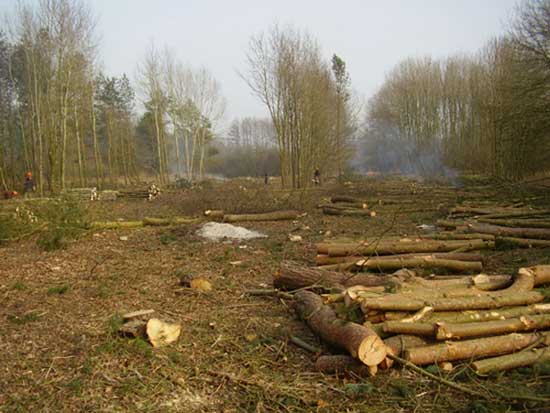
Bleyswycks Bank, February 2008
Restoration work began at the end of February 2008, with the felling of the former tree nursery on Bleyswycks Bank: only field maples, sallows, a clump mature oaks were left standing. A line of ash, parallel with the southern boundary, was pollarded to create a shady walk, screened from the rest of the site.
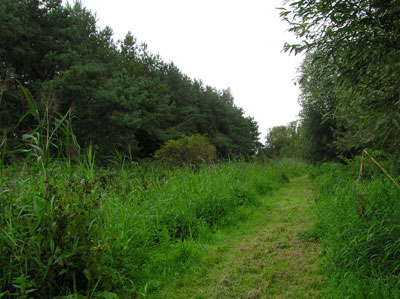
Bleyswycks Bank, August 2007
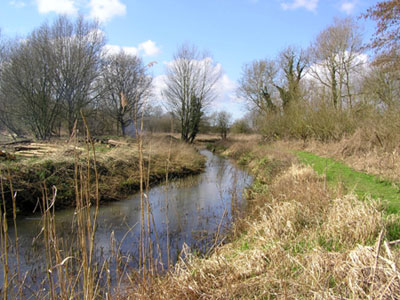
Bleyswycks Bank, August 2008
This work transformed the landscape: these views of Bleyswycks Bank, taken from Bettys Fen on the north side of the river, show how the removal of Scots pines has let much more light into Bettys Fen and opened up the view downstream.
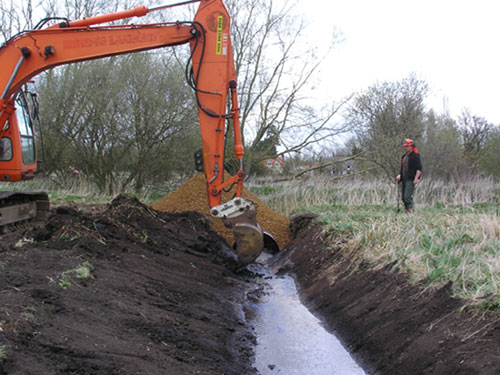
A new culvert
In April 2008 culverts were installed in the ditches to allow vehicle and, eventually, pedestrian access along the river bank. The ditches were re-profiled to make them more attractive to water voles, which started re-colonise the Little Ouse headwaters in 2010.
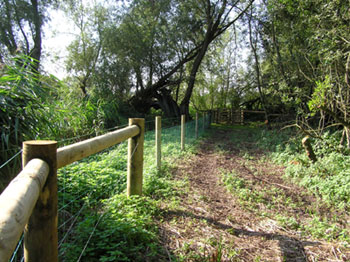
Stock Fence
Fencing was completed in Autumn 2008 in preparation for the eventual introduction of stock. Wide access kissing gates, generously funded by the Country Landowners Association, allow easy access for parents with buggies and for disabled visitors. We regret that parts of this fenland site may be too wet to allow easy disabled access at some times of year but expect that the riverbank path, once completed will allow dry access and enjoyment of the views and much of the sites' wildlife. Please contact the LOHP if you would like to arrange disabled access to any of our sites through the main field gates.
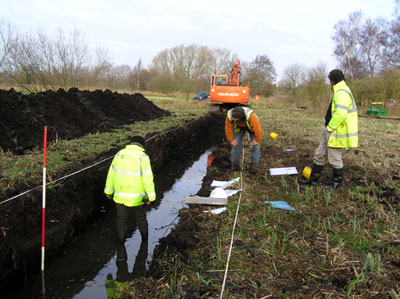
Archaeologists checking a trench
In December 2008 we undertook an archaeological evaluation of the areas of Parkers Piece from which we plan to remove the degraded peaty surface. Removal of material that has been disturbed and enriched by former agricultural activities will expose a wetter and less nutrient-rich peat surface on which some of the area's rarer plants should eventually re-establish. In 1958 archaeologist Basil Brown found a scattering of Iron Age finds at the western end of Parkers Piece, on a sandy area near a meander in the river. Although archaeological finds were less likely on the peat areas, away from the sandy margins of the former fen, we needed to be sure that our plans would not disturb or destroy anything of archaeological importance. Following guidance from Suffolk County Council's archaeologists, we contracted the Cambridge Archaelogy Unit to check an extensive network of trenches and undertake a metal detector survey of the site. No significant finds were made and so the go-ahead was given to start work on the excavation, while maintaining a watchful eye for artefacts. Work on the excavation should begin in the early spring as long as the ground conditions are not too wet.
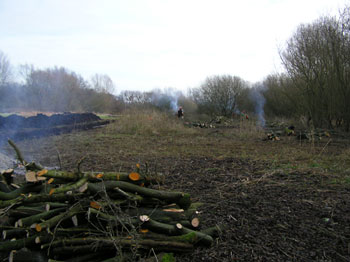
Clearance of recent scrub
At the same time, contractors cleared an area of scrub to make way for the new wetland. The scrub, which was of low value from wildlife, had invaded the site when the water table was very low in the 1970s and 1980s. It has been replaced by new areas of mixed, native shrubs planted on the spoil resulting from surface lowering work, which was spread on drier, southwest corner of the site.
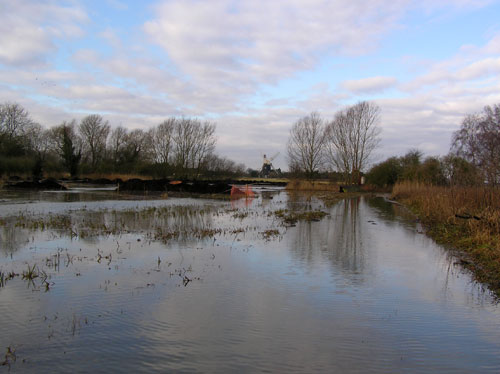
Flooding, Feb 2009
In February 2009, snow melt and heavy rain resulted in a rapid rise in the river level. The river overtopped its bank and flooded most of Parkers Piece and all of Bleyswycks Bank. This set back plans to start work on the final and most radical phase of the project, the lowering of the land surface by removal of degraded and rotted surface peat.
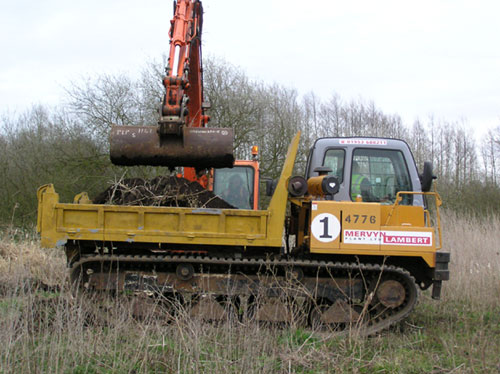
The first load!
Luckily the dry and sunny weather in mid-March dried the site out sufficiently for work to start on Bleyswycks Bank on 23 March. By August excavation and removal of rotted surface peat was completed on both Bleyswycks Bank and Parkers Piece. The peat surface was scraped to depths of 20, 40 and 100 cm, the latter creating a permanent pond on Parkers Piece. Despite the disturbance from heavy machinery, a pair of oystercatchers successfully reared a brood on the edge of the new pond!
By autumn 2009 much of the scraped area was already green and reed was starting to colonise parts of the scraped area. The greening continued throughout 2010 as more species colonised the new surfaces - most arising from buried seed and others dispersing in from near-by sites. Mowing to control weedy colonists, together with grazing by redpoll cattle and Norfolk Horn sheep, started to produce a diverse assemblage of common wetland plants with some fen specialists, such as Meadow Rue and Brookweed starting to appear.
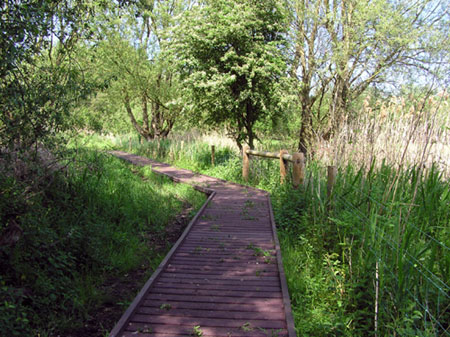
The new boardwalk to Thelnetham Fen
2010 also saw completion of the public access routes and installation of on-site interpretation. Bob's Bridge over the river was masterminded by LOHP trustee Bob Hayward, who also led the construction team - all LOHP volunteers. This, together with a new boardwalk linking Parkers Piece to Thelnetham Fen, opened up many new possibilities for circular walks in the valley. In keeping with our other sites, on-site interpretation took the form of discs of information embedded in distinctive sculptured oak trunks - by local artists Ben Platts-Mills and Andy Manning.
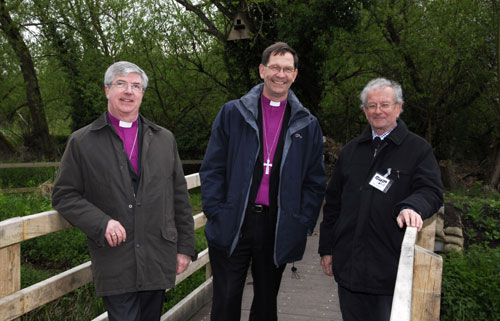
Bishops meet!
To mark completion of all of the major work on the site an official opening ceremony was held on 10th June 2010. The Right Reverend Nigel Stock, Bishop of St Edmundsbury & Ipswich, and the Right Reverend Graham James, Bishop of Norwich, met on the border of their dioceses to open not only the newly restored fens but also Bob's bridge.
Special features
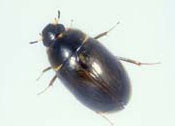
Enochrus nigritus
Enochrus nigritus, a rare water beetle (Red Data Book3), is one of 37 species of water beetles and bugs found during a survey of the large pond on Parkers Piece in September 2010. Even the shallow and seasonally-dry pool on Bleyswycks Bank had 16 species including three that are classified as Nationally Notable.
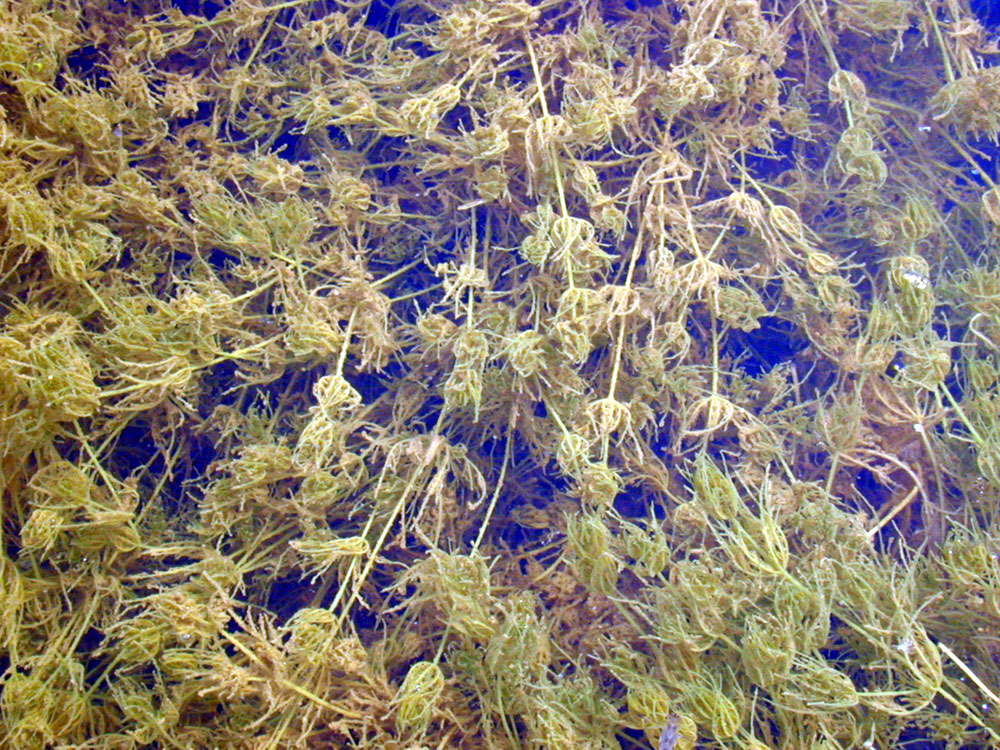
stonewort
The deepest part of the scrape colonised very rapidly with three species of stoneworts. These highly structured algae, with 'stoney' surfaces made of clacium carbonate deposits, are fen specialists.
Access
Paths, linking with other footpaths in the area were established in 2009, allowing this exciting area to be enjoyed for the first time. Volunteers visiting both Parkers Piece and Bleyswycks Bank for work parties are asked to park on the road verge at the western end of the area, just south of Thelnetham Ford.

